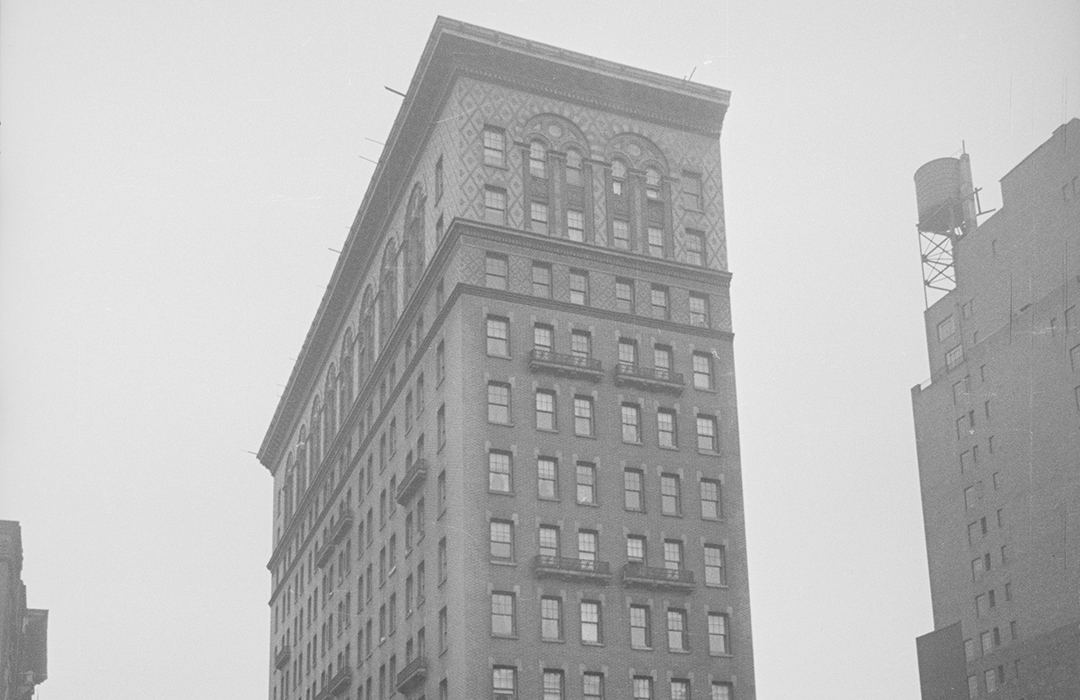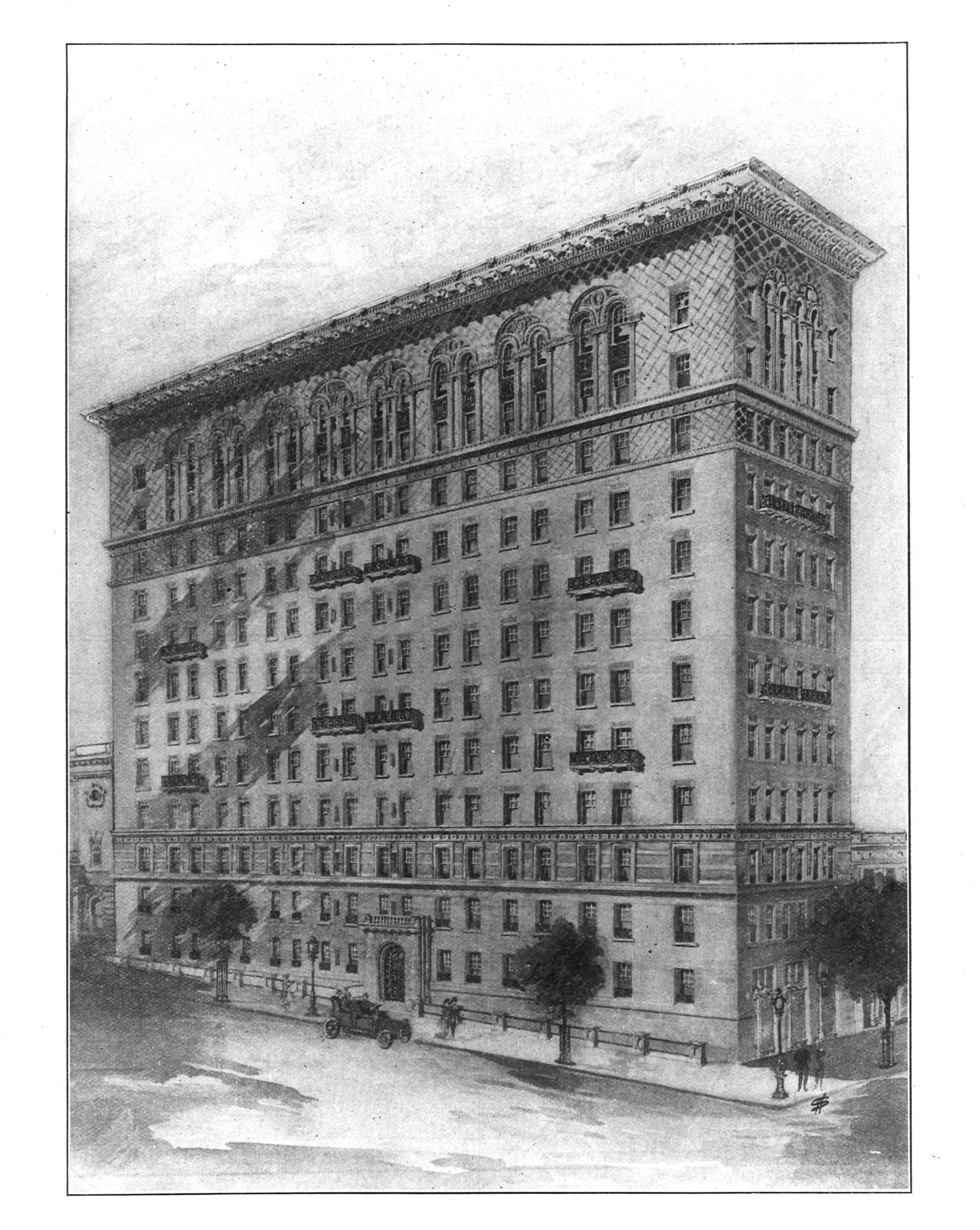
The Allenhurst
by Tom Miller
In 1908 architect William L. Rouse designed a 12-story apartment building for the Allenel Construction Co. on the southeast corner of Broadway and 100th Street. Architects’ and Builders’ Magazine commented, “The site is interesting,” noting that the Broadway side of the plot was 50-feet wide, while the parcel extended 127 along West 100th Street. And, indeed, the 12-story Allenhurst, completed in 1909, had a long, narrow appearance. Construction had cost the developers today’s equivalent of $16.1 million.
Rouse’s tripartite Italian Renaissance design featured bronze-railed balconies scattered along the façade, and double-height arches on the top section, where the brick was diapered in a handsome diamond pattern. Intended for well-to-do families, the Allenhurst had four apartments per floor, with up to four bedrooms (not including the maid’s room).
Like all well-heeled New Yorkers, residents of the Allenhurst maintained summer homes. The country place of the Richard Brandt family was in Amityville, Long Island. The Brandts were most likely about to close the Amityville house on November 5, 1911. Their teenage son, Richard, Jr., who had recently graduated from the private Berkeley School, had been trusted to stay at the Allenhurst apartment alone.
That weekend Richard invited a friend, Joseph Kelly over. Kelly was a graduate of the Staunton Military Academy in Staunton, Virginia, and was now attending college. Richard would have some explaining to do when his parents returned. On Monday morning, he discovered that his father’s valuable fur overcoat was gone. When the Brandts returned a week later, Richard Sr. had the college boy arrested
The Evening World remarked in 1913 that “His chief occupation since the time he inherited the million left by his father…has been to keep money in circulation.”
Also living in the Allenhurst at the time were Colonel Silas W. Burt and his wife, the former Jeanette Ferrell. Burt graduated with an engineering degree from Union College in 1849. His first job was in helping construct the Harlem River Railroad, and in 1852 was made assistant engineer on the construction of the Great Western Railway of Canada. After working on railroads in Ohio and Indiana, he was appointed Deputy Naval Officer of the Port of New York, and in 1878 President Rutherford B. Hayes appointed him Naval Officer. He turned from engineering to civil service in 1883 when he was appointed chief examiner of the Civil Service Commission for New York State. The New-York Tribune called him “a veteran of the long struggle against the spoils of government administration.”
Bertram I. Rich had been a garage owner until 1902 when his father, Alexander Rich, died and left him a fortune of $1.5 million (closer to $46.5 million today). He married Daisy B. Frank that year. His love of nightlife and other women continually landed his name in the newspapers. The Evening World remarked in 1913 that “His chief occupation since the time he inherited the million left by his father…has been to keep money in circulation.”
Rich had three passengers in his automobile (with monogrammed doors) on November 18, 1910. According to The Evening World, they “barely escaped with their lives when his large touring car plunged through a stone wall to the verge of a sixty-foot cliff on Crestmont Road, Montclair, N.J.”
And then, on the night of March 23, 1912, two women, Louise Marshall and Georgiana Brender, were riding in Rich’s touring car in Central Park. As he approached the bridge over the bridle path, his rear wheels skidded. The rear end of the car hit the bridge and, according to The New York Press, “threw out Mrs. Marshall, who was sitting in the front seat beside Rich.” Louise Marshall landed on the roadway 20 feet from the bridge. The New York Times reported, “Miss Bender was not thrown out, but she was injured by glass from the broken wind shield, which was up, and which was crushed when the car struck the wall. Rich stuck to the steering wheel and was not thrown out.” An ambulance from the Arsenal station treated the injured women.
Rich’s bad luck with women and motor vehicles continued the following year. On November 25, 1913, his chauffeur Jeremiah Mahoney, was driving him and Estelle Nelson along Pelham Parkway when he collided with another car, killing the four occupants. The following day The Sun reported, “At the Allenhurst apartments, where Rich lives, it was said that Mrs. Rich had gone to the hospital to bring her husband home.” It may have been the last straw for Daisy. The couple divorced that year.
Press coverage of the residents most often involved marriages, deaths and debutante affairs. But one Allenhurst resident got in trouble with the law in 1916. Mayville Simon and a friend Henry Gluber were taken in by John Granan of the Humane Society, “who accused them of shooting a pigeon,” said The Evening Telegram on January 6, 1916. The judge paroled them to the custody of their parents. Simon was nine years old and Gluber was eight.
In April 1919 the wife of John B. Mayo died in a Rochester, Minnesota sanitarium. Mayo had been appointed Justice of the Court of Special Sessions in 1907. About a month after his wife’s death, Mayo was crossing Amsterdam Avenue at West 73rd Street when he was struck by a grocery wagon. Dr. John F. Girdner, who happened to be passing, helped him to Miss O’Brien’s Sanitarium on West 74th Street. There, according to The Sun, “he was discovered to be suffering from concussion of the brain and bruises about the face and head.” His injuries were, luckily, not fatal.
The Depression years were not kind to the once elegant Allenhurst. By 1941 the apartments had been divided into furnished rooms. In August that year a couple checked in, registering as Mr. and Mrs. Charles Patterson. It is unclear why they used assumed names, but they were, in fact, Charles Alfred and Anna Mary Walling. Six months later, in February, the building’s superintendent, Nathaniel Marble, smelled gas and traced it to their room. The New York Sun reported, “Two burners of a small closet stove were open. Patterson’s body was slumped over in a chair while the woman’s body was in bed. Some partly emptied beer bottles were on a table.” They had left no evidence as to why they committed suicide.
Constance Bennett had thrown her purse out of the window, and then regretted it.
In 1947 the building was converted to an SRO, the Hotel Midway, with 30 rooms per floor. Over the next decades several of its denizens would bring unwanted publicity. Such was the case with 24-year-old Clyde Leon Plunkett, who lived here in 1967. On the evening of November 11, he rushed up behind a 72-year-old woman, pushed her to the sidewalk and ran off with her purse. Passersby helped the victim to a phone booth where she telephoned police. Plunkett was picked up, and the elderly woman identified him in a lineup. A bizarre incident occurred on April 3, 1976. The New York Times reported, “A 29-year-old woman was killed when she plunged 10 stories down an airshaft in the rear of the Midway Hotel.” Constance Bennett had thrown her purse out of the window, and then regretted it. Her companion, 47-year-old Fred McCall, retrieved a fire hose from the hallway, “slit it in half to make it longer, and then attached it to a radiator in the room,” said the newspaper. As Constance tried to climb down the hose, she lost her grip and plunged to the courtyard. McCall was arrested, charged with criminal-neglect homicide.
A side effect of the large number of residents per floor was that the passenger elevators were not intended to carry a heavy load. When 13 people crowded into an elevator on November 24, 1979, it was too much for the cable to handle. The following day The New York Times reported, “Ten persons were reported slightly injured late yesterday when an elevator in which they were riding in a West Side hotel fell seven stories after a cable snapped.”
On the afternoon of June 4, 1996, police arrived at the Midway Hotel to arrest Bonifacio Herreira Mendez for murder, assault, and weapons possession. The 16-year-old illegal Mexican alien was one of 40 uninvited guests who crashed the baptism of a baby girl in a Queens church that Sunday. Half an hour after they arrived shots rang out. One man was killed, and five others wounded.
Called The Midway today, there are four apartments and 29 single-room-occupancy rooms per floor within the building. At some point, the cornice was lost, but it has been replaced with a laudable facsimile. And, overall, William L. Rouse’s handsome 1908 design survives.
Tom Miller is a social historian and blogger at daytoninmanhattan.blogspot.com
Building Database
Keep Exploring
Be a part of history!
Think Local First to support the businesses at 216 West 100th Street:



